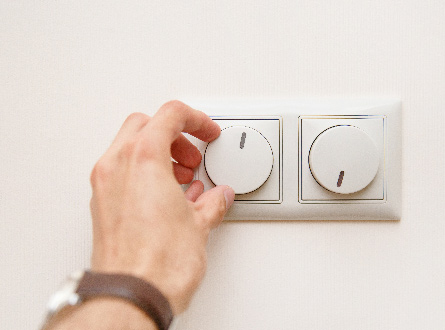Why Do Dimmer Switches Buzz?
Post By: Ryan King On: 22-09-2020 - Smart Homes
Domestic dimmer switches were invented in 1959, and quickly became a very popular way of creating mood lighting in the home. They've moved on a lot since then, and today's dimmer switch is a much more sophisticated piece of tech. Modern dimmer switches offer all sorts of options, which include programmable security timers, slave systems, and fully automated smart switches. You can even get switches that don't need wiring, in innovative concepts such as self-powered wireless dimmers.
Why Do Dimmer Switches Buzz?
One problem that's often encountered with a dimmer switch is that it emits a hum or buzzing noise. It's most commonly caused by a fault in the switch mechanism, or, more commonly, in the light filament.

How Does A Dimmer Switch Work?
Old-style dimmer switches worked by interrupting the flow of electrical current passing from the switch to the light bulb by means of a variable resistor. The result is that the light bulb appears dimmer, but it actually takes more electrical current to divert the current through the resistor. The resistor can thus sometimes overheat and cause vibration in the electromagnetic field, emitting that buzzing sound.
More modern dimmer switches employ a semiconductor switching mechanism inside the unit to turn the mains electricity on and off. This happens in the tiny intervals when the current changes direction from positive to negative. In the UK mains supply, this occurs 50 times per second. During every current reversal there will be zero electrical voltage, and since each AC cycle comprises two direction changes, this means there are 100 interruptions per second to the circuit.
The lighting circuit will turn back on once the voltage returns to a sufficient level of power; this is dictated by the setting on your dimmer switch. The brighter your light setting, the more quickly the current will switch back on after the interruption, supplying the light bulb with a greater amount of energy per second. For dimmer settings, the current will be turned off for a greater proportion of the AC cycle.
Is A Buzzing Dimmer Switch Dangerous?
The quick answer to this is – maybe. If the buzz is coming from the light bulb, which is very common, then changing the bulb is a simple and safe operation. You might need a different type of bulb if you find the buzzing continues even with a new one. Vibrations in the magnetic field are more likely to cause damage in more decorative bulbs, which often have longer and less robust filaments. Try changing to a standard light bulb to see if the problem persists, or even a rough service bulb which has much tougher filaments. Make sure also that your bulbs are the right wattage, and are specified for use with a dimmer switch. If you're deploying multiple bulbs in a lighting array, you might need to reduce the wattage of the bulbs so as not to overload the circuit – or reduce the number of bulbs.
If the buzz is coming directly from the switch unit, breaker box or lighting circuits, then you may have a more serious problem. If it's a wired switch, then the wiring may be loose, faulty, wrongly wired or not grounded properly. The circuit may be overloading or arcing, or might at any moment fail to shut off. Poorly or improperly connected wires might fail to activate the circuit breaker. Any of these circumstances represent a potential fire hazard, so don't try to fix such electrical problems yourself. Immediately shut down all the electrical circuits and call an electrician.
Upgrading Your Dimmer Switch
An alternative to reducing your light bulb wattage is to upgrade your switch. If you're wondering why your dimmer switch is still buzzing, it may be that it is rated too low for the task, and is being overtaxed by the combined bulb wattage. Try taking a few bulbs out of the switch circuit and see if it reduces the buzzing. If it does, then your dimmer switch is probably working above its specified capacity, and you should consider an upgrade to a higher rating.
Older or cheaper switches may still be using the variable resistor model to interrupt the current, and could be suffering from electromagnetic vibration. The better quality autotransformer model dimmer switches could significantly reduce the buzzing. More modern dimmer switches are also designed for use with LED or compact fluorescent bulbs, which can be dimmed more efficiently than the older models with CFL bulbs.
How To Replace Your Dimmer Switch
It is possible to replace a dimmer switch yourself, provided you pay careful attention to the procedure, and know something about wiring. However, if you're at all unsure of what to do, then we strongly recommend that you contact a qualified electrician.
Tools required to install a new or upgraded dimmer switch:
- A selection of screwdrivers
- Wire strippers
- Wire connectors
- A non-contact voltage tester

What To Do
1. First Of All, Turn Off The Electrical Power To The Lighting Circuit.
This means locating the relevant circuit breaker in the breaker box or panel, and flipping the switch to OFF
2. Use The Non-Contact Voltage Tester To Confirm That The Power Is Definitely Off
Carefully unscrew the cover plate on your dimmer switch and remove it. Then unscrew the mounting screws attaching the switch mechanism to its housing. Being very careful not to touch any wires, gently remove the switch from its housing. Apply the non-contact voltage tester to each of the switch wires to ensure they are inactive.
3. Remove The Old Unit
Each set of wires will be connected to the switch with a wire connector. You'll need to unscrew this and separate each pair of wires before you can remove the switch.
4. Connect The New Unit
If the wire ends on the new dimmer switch have not already been stripped, use the wire strippers to strip off 0.5 inches or 12.7mm of the insulation on each of the wire leads. Then use a wire connector to connect the ground lead on the switch to the circuit ground wire in the switch housing. Next, connect each of the live wire leads on the switch unit to one of the live circuit wires in the housing. If the housing contains any neutral wires, they won't normally be connected to the switch.
You need to be absolutely sure you know your wiring colour codes before undertaking a job of this kind, particularly as these may have changed since the time when your old switch was constructed. Again, it is recommended that you contact a qualified electrician to install the new switch if you are in any doubt.
5. Mount The New Switch
Fit the new switch into its housing, tucking in the wires before screwing it in securely with the mounting screws, and mounting the switch cover plate.
6. Test The New Unit
Switch the circuit breaker back on in the breaker box so power is ON. Confirm that you have the correct wattage and style of light bulbs installed for your new dimmer, and then give it a test drive to make sure it's working properly.
Get More From Rowse Straight To Your Inbox




